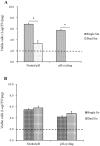Streptococcus oligofermentans Inhibits Streptococcus mutans in Biofilms at Both Neutral pH and Cariogenic Conditions
- PMID: 26114758
- PMCID: PMC4483167
- DOI: 10.1371/journal.pone.0130962
Streptococcus oligofermentans Inhibits Streptococcus mutans in Biofilms at Both Neutral pH and Cariogenic Conditions
Abstract
Homeostasis of oral microbiota can be maintained through microbial interactions. Previous studies showed that Streptococcus oligofermentans, a non-mutans streptococci frequently isolated from caries-free subjects, inhibited the cariogenic Streptococcus mutans by the production of hydrogen peroxide (HP). Since pH is a critical factor in caries formation, we aimed to study the influence of pH on the competition between S. oligofermentans and S. mutans in biofilms. To this end, S. mutans and S. oligofermentans were inoculated alone or mixed at 1:1 ratio in buffered biofilm medium in a 96-well active attachment model. The single- and dual-species biofilms were grown under either constantly neutral pH or pH-cycling conditions. The latter includes two cycles of 8 h neutral pH and 16 h pH 5.5, used to mimic cariogenic condition. The 48 h biofilms were analysed for the viable cell counts, lactate and HP production. The last two measurements were carried out after incubating the 48 h biofilms in buffers supplemented with 1% glucose (pH 7.0) for 4 h. The results showed that S. oligofermentans inhibited the growth of S. mutans in dual-species biofilms under both tested pH conditions. The lactic acid production of dual-species biofilms was significantly lower than that of single-species S. mutans biofilms. Moreover, dual-species and single-species S. oligofermentans biofilms grown under pH-cycling conditions (with a 16 h low pH period) produced a significantly higher amount of HP than those grown under constantly neutral pH. In conclusion, S. oligofermentans inhibited S. mutans in biofilms not only under neutral pH, but also under pH-cycling conditions, likely through HP production. S. oligofermentans may be a compelling probiotic candidate against caries.
Conflict of interest statement
Figures




References
-
- Marsh P (1994) Microbial ecology of dental plaque and its significance in health and disease. Advances in dental research 8: 263–271. - PubMed
MeSH terms
Substances
LinkOut - more resources
Full Text Sources
Other Literature Sources
Research Materials
Miscellaneous

